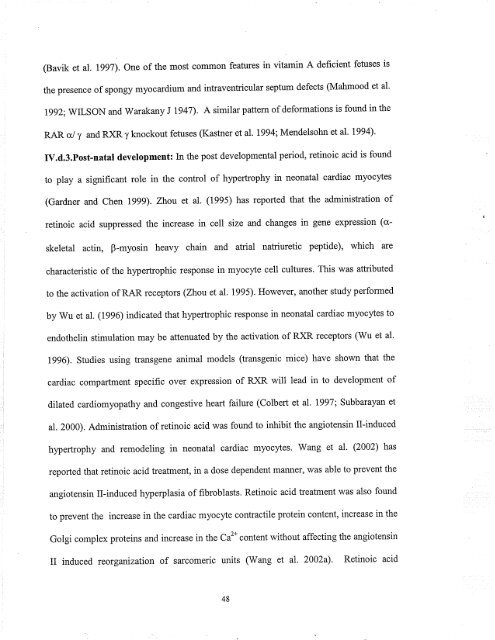il\VOLVEMENT OF RETII\OIC ACID II{ - MSpace at the University of ...
il\VOLVEMENT OF RETII\OIC ACID II{ - MSpace at the University of ...
il\VOLVEMENT OF RETII\OIC ACID II{ - MSpace at the University of ...
Create successful ePaper yourself
Turn your PDF publications into a flip-book with our unique Google optimized e-Paper software.
(Bavik et al. 1997). One <strong>of</strong> <strong>the</strong> most common fe<strong>at</strong>ures in vitamin A deficient fetuses is<br />
<strong>the</strong> presence <strong>of</strong> spongy myocardium and intraventricular septum defects (Mahmood et al'<br />
1992;W1LSON and Warakany J 1947). A similar p<strong>at</strong>tern <strong>of</strong> deform<strong>at</strong>ions is found in <strong>the</strong><br />
RAR crl y and RXR y knockout fetuses (Kastner et al. 1994; Mendelsohn et al. 1994)'<br />
IV.d.3.Post-n<strong>at</strong>al development: In <strong>the</strong> post developmental period, retinoic acid is found<br />
to play a significant role in <strong>the</strong> control <strong>of</strong> hypertrophy in neon<strong>at</strong>al cardiac myocytes<br />
(Gardner and Chen lggg). Zhot et al. (1995) has reported th<strong>at</strong> <strong>the</strong> administr<strong>at</strong>ion <strong>of</strong><br />
retinoic acid suppressed <strong>the</strong> increase in cell size and changes in gene expression (askeletal<br />
actin, B-myosin heavy chain and <strong>at</strong>rial n<strong>at</strong>riuretic peptide), which are<br />
characteristic <strong>of</strong> <strong>the</strong> hypertrophic response in myocyte cell cultures. This was <strong>at</strong>tributed<br />
to <strong>the</strong> activ<strong>at</strong>ion <strong>of</strong> RAR receptors (Zhot et al. 1995). However, ano<strong>the</strong>r study performed<br />
by'Wu et al. (1996) indic<strong>at</strong>ed th<strong>at</strong> hypertrophic response in neon<strong>at</strong>al cardiac myocytes to<br />
endo<strong>the</strong>lin stimul<strong>at</strong>ion may be <strong>at</strong>tenu<strong>at</strong>ed by <strong>the</strong> activ<strong>at</strong>ion <strong>of</strong> RXR receptors (Wu et al.<br />
1996). Studies using transgene animal models (transgenic mice) have shown th<strong>at</strong> <strong>the</strong><br />
cardiac compartment specific over expression <strong>of</strong> RXR will lead in to development <strong>of</strong><br />
dil<strong>at</strong>ed cardiomyop<strong>at</strong>hy and congestive heart failure (Colbert eI al. l99l; Subbarayan et<br />
a1. 2000). Administr<strong>at</strong>ion <strong>of</strong> retinoic acid was found to inhibit <strong>the</strong> angiotensin ll-induced<br />
hypertrophy and remodeling in neon<strong>at</strong>al cardiac myocytes. Wang et al' (2002) has<br />
reported th<strong>at</strong> retinoic acid tre<strong>at</strong>ment, in a dose dependent manner, was able to prevent <strong>the</strong><br />
angiotensin Il-induced hyperplasia <strong>of</strong> fibroblasts. Retinoic acid tre<strong>at</strong>ment was also found<br />
to prevent <strong>the</strong> increase in <strong>the</strong> cardiac myocyte contractile protein content, increase in <strong>the</strong><br />
Golgi complex proteins and increase in <strong>the</strong> Ca2* content without affecting <strong>the</strong> angiotensin<br />
<strong>II</strong> induced reorganiz<strong>at</strong>ion <strong>of</strong> sarcomeric units (Wang et al. 2002a). Retinoic acid<br />
48







![an unusual bacterial isolate from in partial fulf]lment for the ... - MSpace](https://img.yumpu.com/21942008/1/190x245/an-unusual-bacterial-isolate-from-in-partial-fulflment-for-the-mspace.jpg?quality=85)





![in partial fulfil]ment of the - MSpace - University of Manitoba](https://img.yumpu.com/21941988/1/190x245/in-partial-fulfilment-of-the-mspace-university-of-manitoba.jpg?quality=85)


